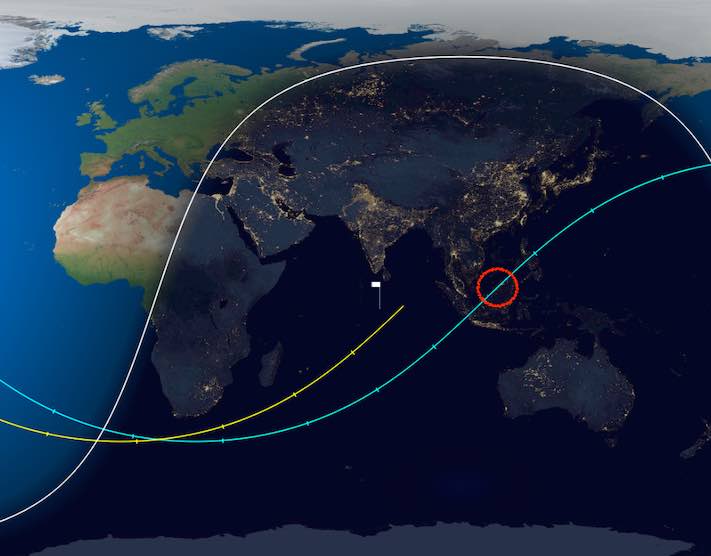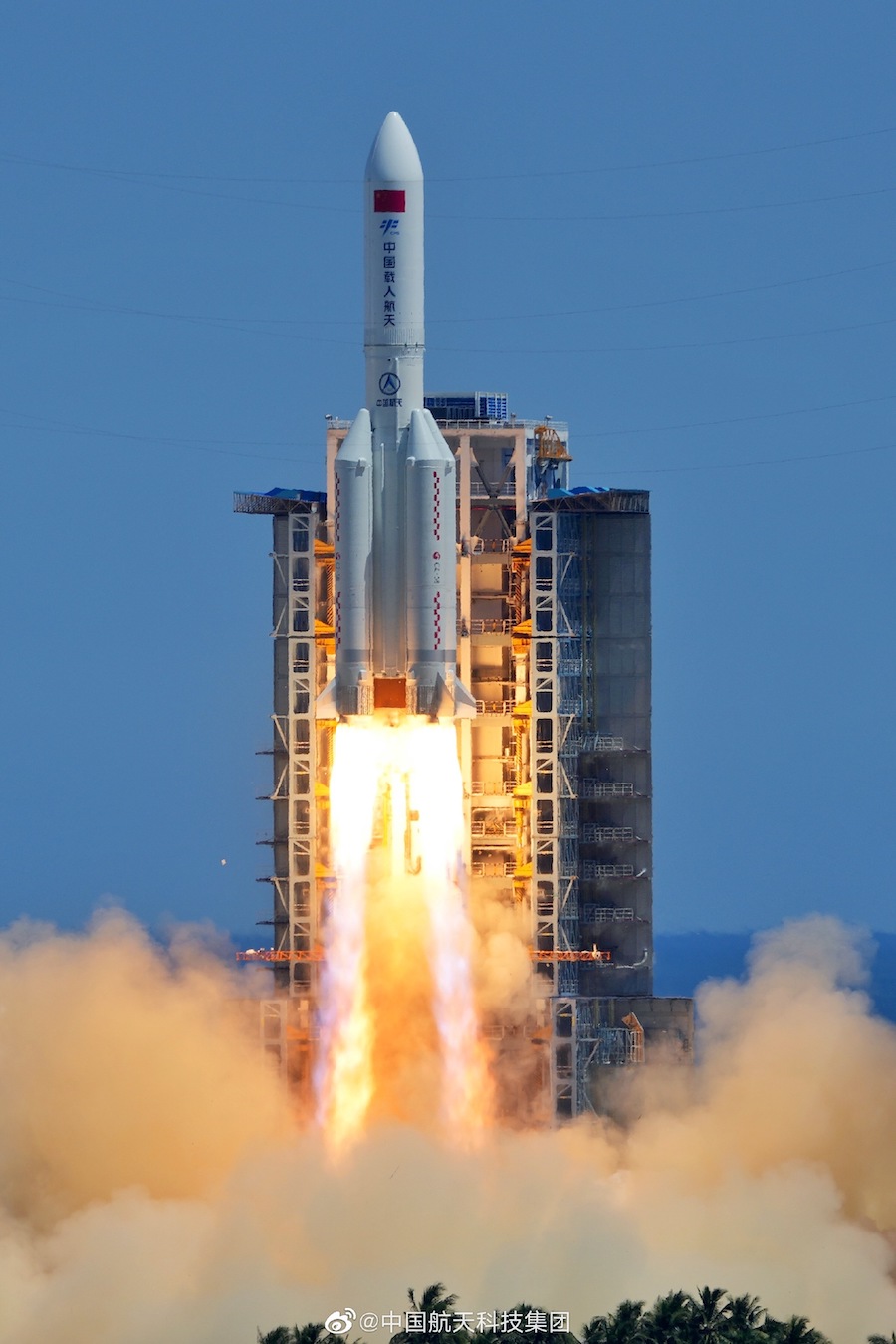EDITOR’S NOTE: Updated after confirmation of re-entry.

The 22-ton core stage of a Chinese rocket fell back to Earth Saturday, the third time in two years China has allowed such a large booster to re-enter the atmosphere uncontrolled. There were no immediate reports of wreckage or damage on the ground. Space debris experts said the unguided re-entry posed a low but avoidable risk to the world’s population.
The Long March 5B rocket took off July 24 with the Wentian module for China’s Tiangong space station, hauling one of the heaviest payloads launched into orbit in recent years. The nearly 100-foot-long (30-meter) core stage of the Long March 5B rocket fired its two hydrogen-fueled engines for about eight minutes to inject the Wentian module into orbit.
Four strap-on boosters burned their propellant and jettisoned a few minutes after launch to fall into the South China Sea. But the design of the Long March 5B, one of the most powerful operational rockets in the world, means its core stage accelerates to orbital velocity.
Most launchers carry an upper stage to finish the job of placing a payload into orbit, leaving the booster to fall back to Earth in the ocean or to be recovered for reuse, as SpaceX does with its Falcon 9 rocket.
U.S. Space Command, which tracks objects in orbit, confirmed the Long March 5B rocket stage re-entered the atmosphere around 12:45 p.m. EDT (1645 GMT). The China Manned Space Agency said in a statement that any surviving debris from the rocket fell into the Sulu Sea around 9.1 degrees north latitude and 119 degrees east longitude.
Multiple posts on social media, including the one below, showed what appeared to be debris from the Long March 5B rocket burning up in the atmosphere. The tweet below shows a video captured in Kuching, Malaysia, on the island of Borneo.
meteor spotted in kuching! #jalanbako 31/7/2022 pic.twitter.com/ff8b2zI2sw
— Nazri sulaiman (@nazriacai) July 30, 2022
There were no immediate reports of any debris landing near populated areas, but the unguided re-entry raised concerns about China’s practices for disposal of space junk.
“The People’s Republic of China (PRC) did not share specific trajectory information as their Long March 5B rocket fell back to Earth,” NASA Administrator Bill Nelson said in a statement Saturday.
“All spacefaring nations should follow established best practices, and do their part to share this type of information in advance to allow reliable predictions of potential debris impact risk, especially for heavy-lift vehicles, like the Long March 5B, which carry a significant risk of loss of life and property,” Nelson said. “Doing so is critical to the responsible use of space and to ensure the safety of people here on Earth.”
The Long March 5B rocket’s orbit took it between 41.5 degrees north and south latitude during each hour-and-a-half lap around Earth. The land between those latitudes is home to about 88% of the world’s population.
“It’s low risk on a global scale, but it’s unnecessary risk, and it can affect people, so that’s why we’re talking about it,” said Ted Muelhaupt, a consultant at Aerospace Corp. and an expert on the re-entry of space debris, in a conference call with reporters before the re-entry.
It was impossible to predict exactly when and where the rocket re-enter the atmosphere, but surviving debris was expected to fall in a long, narrow footprint hundreds miles long and up to a few dozen miles across. Statistically, the rocket wreckage was most likely to fall into the ocean or in unpopulated areas.
This was the third time China has left a Long March 5B core stage in orbit to come back to Earth in an unguided manner. The uncontrolled re-entry of the first Long March 5B core stage in 2020 spread debris over the Ivory Coast. The Long March 5B re-entry last year occurred over the Indian Ocean, and no debris was found.
The window of uncertainty around when the rocket will re-enter the atmosphere was largely due to unknowns about the rocket’s orientation and the ever-changing density of the upper atmosphere, which is driven by solar activity that causes the atmosphere to expand or contact, according Muelhaupt.
The window for a re-entry estimate shrinks as the time of the event gets closer. Five days before re-entry, experts estimated the window with an error of plus or minus one day. By Saturday morning, just a few hours before re-entry, the error reduced to plus or minus one hour.

Aerodynamic drag eventually slowed the rocket’s velocity enough to allow Earth’s gravity to pull back into the atmosphere, where most of the booster stage will burn up. Muelhaupt estimated about 4 to 9 metric tons, or 20% to 40% of the rocket’s dry mass, would survive the scorching heat of re-entry and reach Earth’s surface.
Abandoned rocket bodies and dead satellites regularly re-enter the atmosphere. Around 50 human-made objects weighing more than a ton re-enter the atmosphere in an uncontrolled manner each year, according to Muelhaupt.
But the Long March 5B core stage that fell to Earth Saturday was the sixth largest object to re-enter the atmosphere, not including the space shuttle, Muelhaupt said.
The Aerospace Corp. estimated the probability of a piece of the Long March 5B core stage killing or injuring a person to be between 1-in-230 and 1-in-1,000, meaning there was a 99.5% chance there would be zero casualties from the re-entry.
But U.S. government policy guidelines call for managers of space missions to ensure the risk of a death or injury from a re-entry to be no higher than 1-in-10,000. The risk of harm from the Long March 5B re-entry was estimated to be at least 10 times the standard risk threshold for U.S. space missions.
“When it comes down, it will certainly exceed the 1-in-10,000 threshold that is the generally accepted guideline,” Muelhaupt said a few days before the re-entry. “And one of the reasons we’re paying particular attention to this is that in May of 2020, the first test launch of this let debris come down in Africa.”
The risk from the re-entry for any single person was even lower — 6-in-10 trillion, according to the Aerospace Corp. assessment.
“The reality is there are a number of things that you can do about this type of thing, particularly if you’re thinking ahead with your with your mission,” said Marlon Sorge, executive director of Aerospace’s Center for Orbital and Reentry Debris Studies.
For example, designers can select materials that are more likely to burn up during re-entry, reducing the risk of any debris surviving to impact Earth’s surface.
“With the rocket bodies, they’re just so big that it doesn’t really matter what you do during during your design phase in terms of what you make it of. You’ve got huge chunks of metal where the engines are,” Sorge said.
“But there are other approaches that you can do if you think head, and one of those is controlled re-entry,” Sorge said. “Basically, once you’re done delivering your payload, you turn your rocket around, fire the engine and drive it back into the ocean somewhere, usually, someplace where there’s no population. You do that, and you have pretty much mitigated the risk right there. And that’s one of the things that is done by the U.S. government to mitigate these types of risks.”
Wang Wenbin, a spokesperson for the Chinese Foreign Ministry, said in a press conference last year that it is “common practice” for upper stages of rockets to burn up while re-entering the atmosphere. He incorrectly referred to the Long March 5B rocket body as an upper stage, and said that “most of its parts will burn up upon re-entry, making the likelihood of damage to aviation or ground facilities and activities extremely low.”
But no other launcher in the world leaves such a massive component in orbit to fall back to Earth. Dead satellites and old rocket stages regularly re-enter the atmosphere, but re-entering objects with masses of more than a few tons are rare.
“Why are we worried? Well, it did cause property damage the last time (a Long March 5B re-entered),” Muelhaupt said this week. “People are having to do preparation as a result.
“And furthermore, this is not needed,” he said. “We have the technology to not have this problem. Every time you see a Falcon 9 land, that core stage is not going to fall somewhere randomly. Bringing things down deliberately in the ocean, when they’re big enough to cause damage, that is the practice we’d like to encourage.”
China plans to launch its next space station module on another Long March 5B rocket in October. The core stage from that mission is expected to make another uncontrolled re-entry one-to-two weeks after launch.
Email the author.
Follow Stephen Clark on Twitter: @StephenClark1.
"entry" - Google News
July 31, 2022 at 10:56AM
https://ift.tt/IC9tqwW
Re-entry of large Chinese rocket booster spotted over Borneo – Spaceflight Now - Spaceflight Now
"entry" - Google News
https://ift.tt/oNkX4Bf
https://ift.tt/UR8qwbk
Bagikan Berita Ini














0 Response to "Re-entry of large Chinese rocket booster spotted over Borneo – Spaceflight Now - Spaceflight Now"
Post a Comment